VOLVO XC90 2013 Owner´s Manual
Manufacturer: VOLVO, Model Year: 2013, Model line: XC90, Model: VOLVO XC90 2013Pages: 310, PDF Size: 8.62 MB
Page 221 of 310
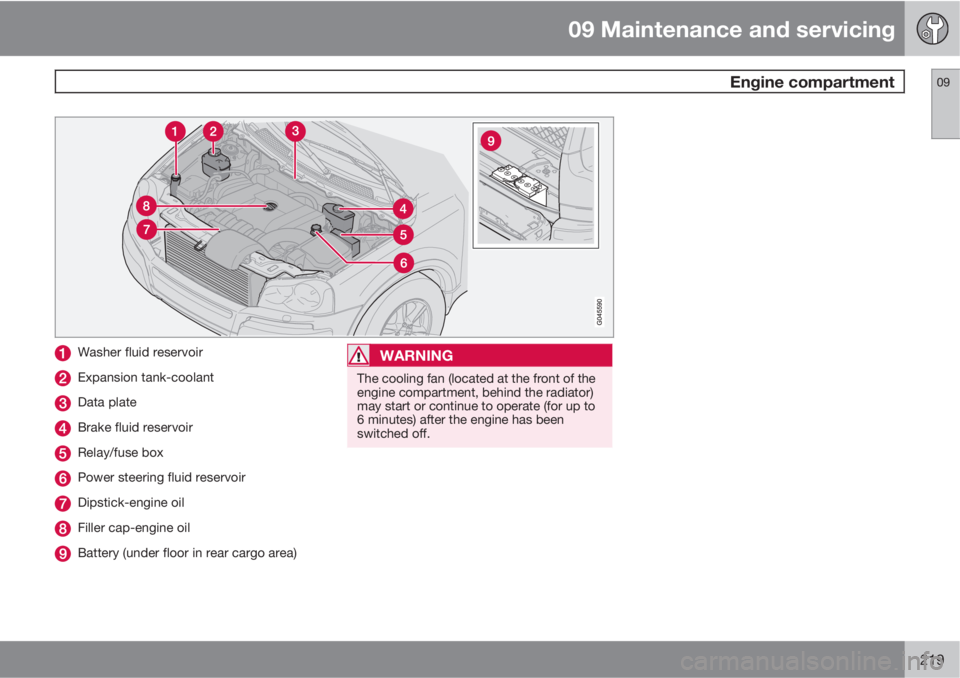
09 Maintenance and servicing
Engine compartment09
219
Washer fluid reservoir
Expansion tank-coolant
Data plate
Brake fluid reservoir
Relay/fuse box
Power steering fluid reservoir
Dipstick-engine oil
Filler cap-engine oil
Battery (under floor in rear cargo area)
WARNING
The cooling fan (located at the front of the
engine compartment, behind the radiator)
may start or continue to operate (for up to
6 minutes) after the engine has been
switched off.
Page 222 of 310
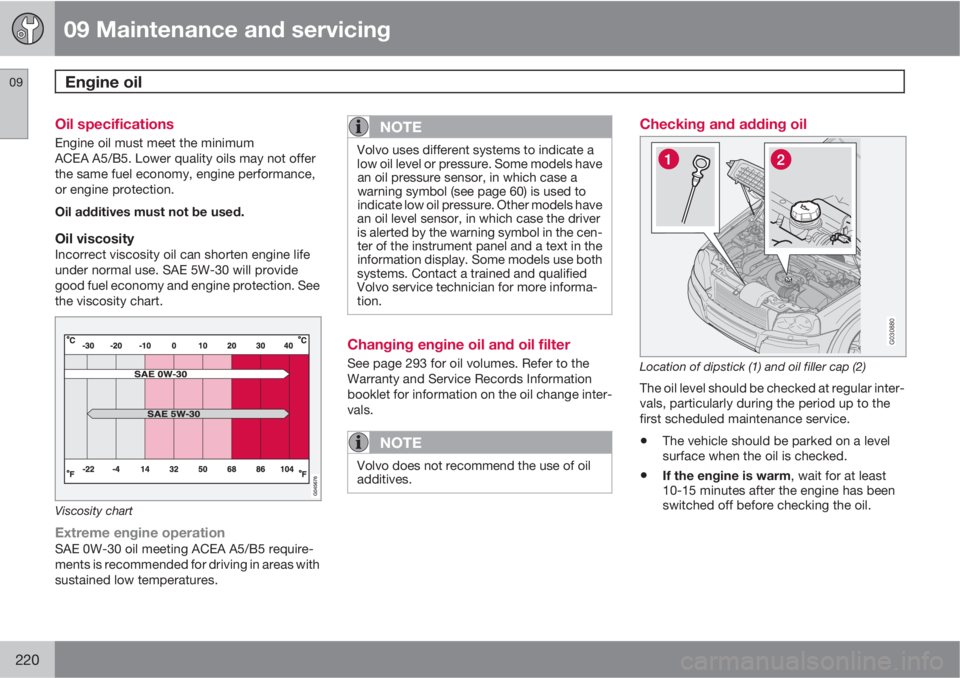
09 Maintenance and servicing
Engine oil 09
220
Oil specifications
Engine oil must meet the minimum
ACEA A5/B5. Lower quality oils may not offer
the same fuel economy, engine performance,
or engine protection.
Oil additives must not be used.
Oil viscosityIncorrect viscosity oil can shorten engine life
under normal use. SAE 5W-30 will provide
good fuel economy and engine protection. See
the viscosity chart.
Viscosity chart
Extreme engine operationSAE 0W-30 oil meeting ACEA A5/B5 require-
ments is recommended for driving in areas with
sustained low temperatures.
NOTE
Volvo uses different systems to indicate a
low oil level or pressure. Some models have
an oil pressure sensor, in which case a
warning symbol (see page 60) is used to
indicate low oil pressure. Other models have
an oil level sensor, in which case the driver
is alerted by the warning symbol in the cen-
ter of the instrument panel and a text in the
information display. Some models use both
systems. Contact a trained and qualified
Volvo service technician for more informa-
tion.
Changing engine oil and oil filter
See page 293 for oil volumes. Refer to the
Warranty and Service Records Information
booklet for information on the oil change inter-
vals.
NOTE
Volvo does not recommend the use of oil
additives.
Checking and adding oil
G030880
Location of dipstick (1) and oil filler cap (2)
The oil level should be checked at regular inter-
vals, particularly during the period up to the
first scheduled maintenance service.
•The vehicle should be parked on a level
surface when the oil is checked.
•If the engine is warm, wait for at least
10-15 minutes after the engine has been
switched off before checking the oil.
Page 223 of 310
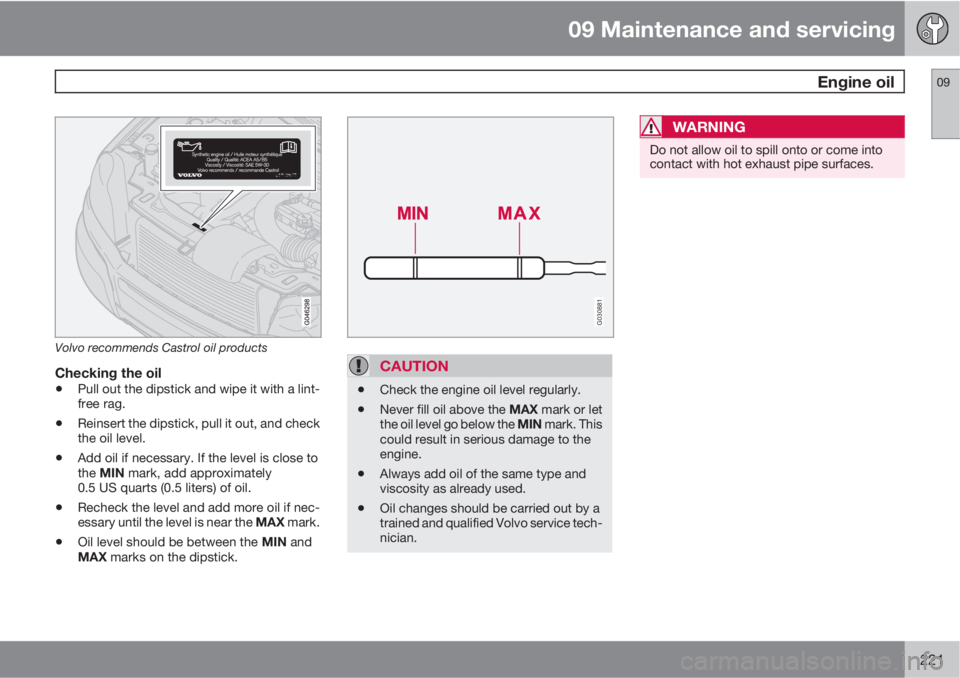
09 Maintenance and servicing
Engine oil09
221
Volvo recommends Castrol oil products
Checking the oil
•Pull out the dipstick and wipe it with a lint-
free rag.
•Reinsert the dipstick, pull it out, and check
the oil level.
•Add oil if necessary. If the level is close to
the MIN mark, add approximately
0.5 US quarts (0.5 liters) of oil.
•Recheck the level and add more oil if nec-
essary until the level is near the MAX mark.
•Oil level should be between the
MIN and
MAX marks on the dipstick.
G030881
CAUTION
•Check the engine oil level regularly.
•Never fill oil above the MAX mark or let
the oil level go below the MIN mark. This
could result in serious damage to the
engine.
•Always add oil of the same type and
viscosity as already used.
•Oil changes should be carried out by a
trained and qualified Volvo service tech-
nician.
WARNING
Do not allow oil to spill onto or come into
contact with hot exhaust pipe surfaces.
Page 224 of 310
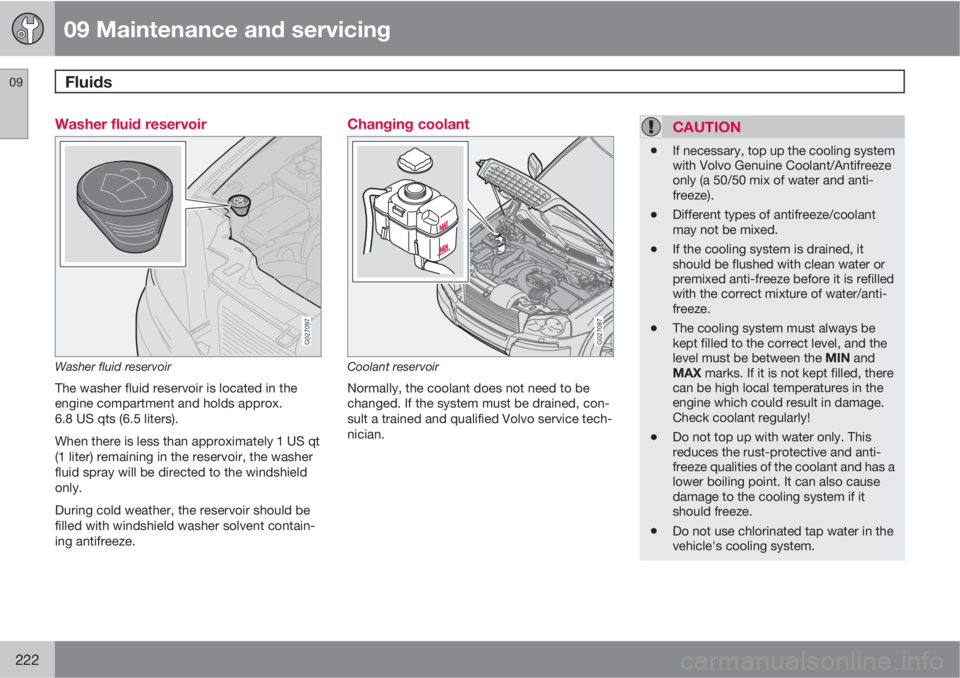
09 Maintenance and servicing
Fluids 09
222
Washer fluid reservoir
G027097
Washer fluid reservoir
The washer fluid reservoir is located in the
engine compartment and holds approx.
6.8 US qts (6.5 liters).
When there is less than approximately 1 US qt
(1 liter) remaining in the reservoir, the washer
fluid spray will be directed to the windshield
only.
During cold weather, the reservoir should be
filled with windshield washer solvent contain-
ing antifreeze.
Changing coolant
G027087
Coolant reservoir
Normally, the coolant does not need to be
changed. If the system must be drained, con-
sult a trained and qualified Volvo service tech-
nician.
CAUTION
•If necessary, top up the cooling system
with Volvo Genuine Coolant/Antifreeze
only (a 50/50 mix of water and anti-
freeze).
•Different types of antifreeze/coolant
may not be mixed.
•If the cooling system is drained, it
should be flushed with clean water or
premixed anti-freeze before it is refilled
with the correct mixture of water/anti-
freeze.
•The cooling system must always be
kept filled to the correct level, and the
level must be between the MIN and
MAX marks. If it is not kept filled, there
can be high local temperatures in the
engine which could result in damage.
Check coolant regularly!
•Do not top up with water only. This
reduces the rust-protective and anti-
freeze qualities of the coolant and has a
lower boiling point. It can also cause
damage to the cooling system if it
should freeze.
•Do not use chlorinated tap water in the
vehicle's cooling system.
Page 225 of 310
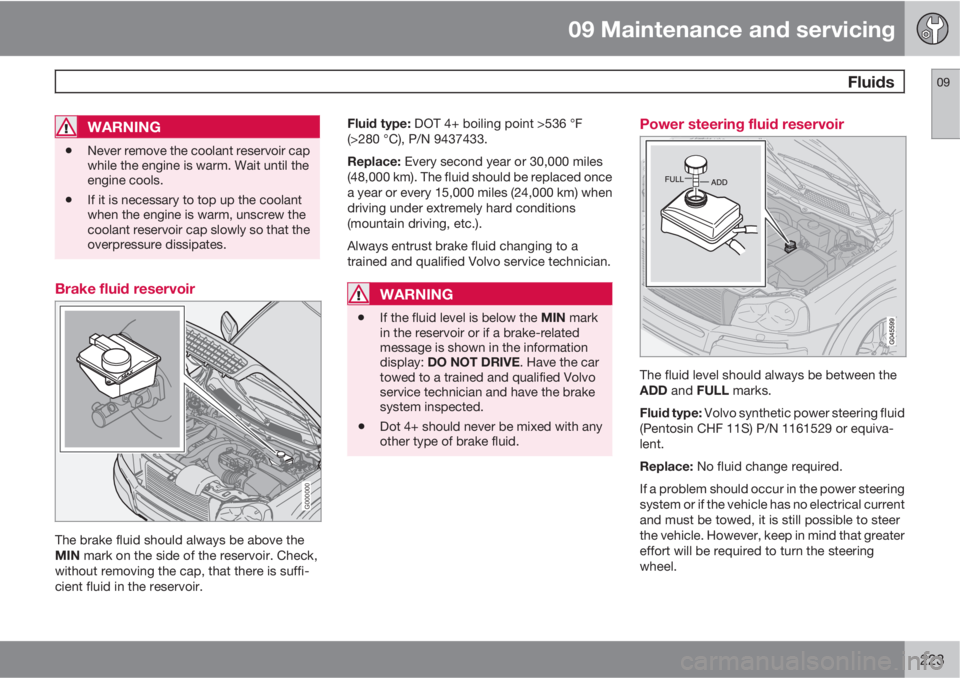
09 Maintenance and servicing
Fluids09
223
WARNING
•Never remove the coolant reservoir cap
while the engine is warm. Wait until the
engine cools.
•If it is necessary to top up the coolant
when the engine is warm, unscrew the
coolant reservoir cap slowly so that the
overpressure dissipates.
Brake fluid reservoir
G000000
The brake fluid should always be above the
MIN mark on the side of the reservoir. Check,
without removing the cap, that there is suffi-
cient fluid in the reservoir.Fluid type: DOT 4+ boiling point >536 °F
(>280 °C), P/N 9437433.
Replace: Every second year or 30,000 miles
(48,000 km). The fluid should be replaced once
a year or every 15,000 miles (24,000 km) when
driving under extremely hard conditions
(mountain driving, etc.).
Always entrust brake fluid changing to a
trained and qualified Volvo service technician.
WARNING
•If the fluid level is below the MIN mark
in the reservoir or if a brake-related
message is shown in the information
display: DO NOT DRIVE. Have the car
towed to a trained and qualified Volvo
service technician and have the brake
system inspected.
•Dot 4+ should never be mixed with any
other type of brake fluid.
Power steering fluid reservoir
The fluid level should always be between the
ADD and FULL marks.
Fluid type: Volvo synthetic power steering fluid
(Pentosin CHF 11S) P/N 1161529 or equiva-
lent.
Replace: No fluid change required.
If a problem should occur in the power steering
system or if the vehicle has no electrical current
and must be towed, it is still possible to steer
the vehicle. However, keep in mind that greater
effort will be required to turn the steering
wheel.
Page 226 of 310
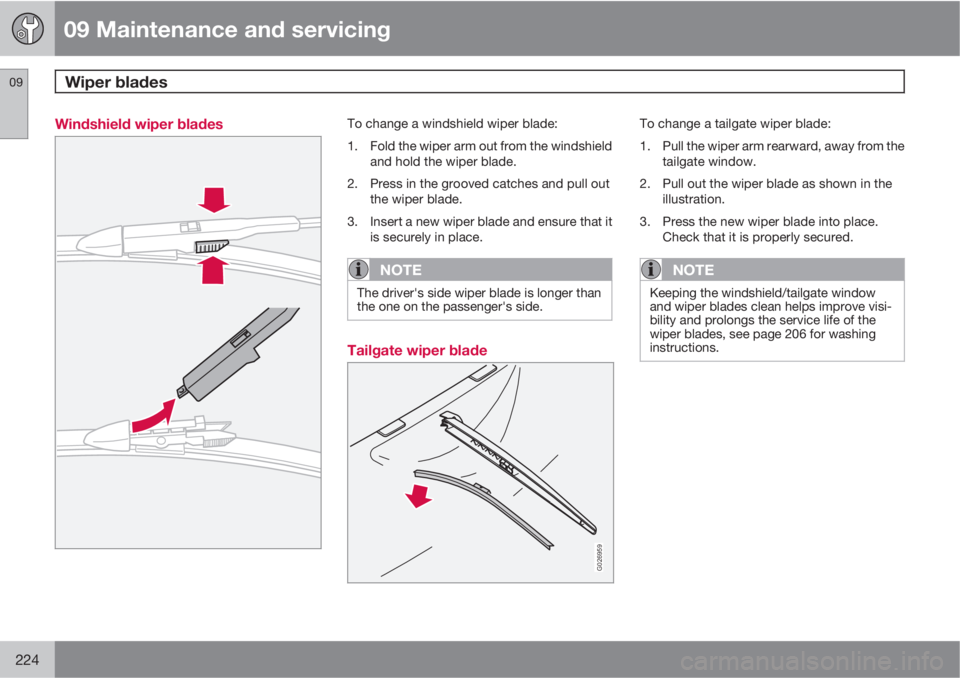
09 Maintenance and servicing
Wiper blades 09
224
Windshield wiper bladesTo change a windshield wiper blade:
1. Fold the wiper arm out from the windshield
and hold the wiper blade.
2. Press in the grooved catches and pull out
the wiper blade.
3. Insert a new wiper blade and ensure that it
is securely in place.
NOTE
The driver's side wiper blade is longer than
the one on the passenger's side.
Tailgate wiper blade
G026959
To change a tailgate wiper blade:
1. Pull the wiper arm rearward, away from the
tailgate window.
2. Pull out the wiper blade as shown in the
illustration.
3. Press the new wiper blade into place.
Check that it is properly secured.
NOTE
Keeping the windshield/tailgate window
and wiper blades clean helps improve visi-
bility and prolongs the service life of the
wiper blades, see page 206 for washing
instructions.
Page 227 of 310
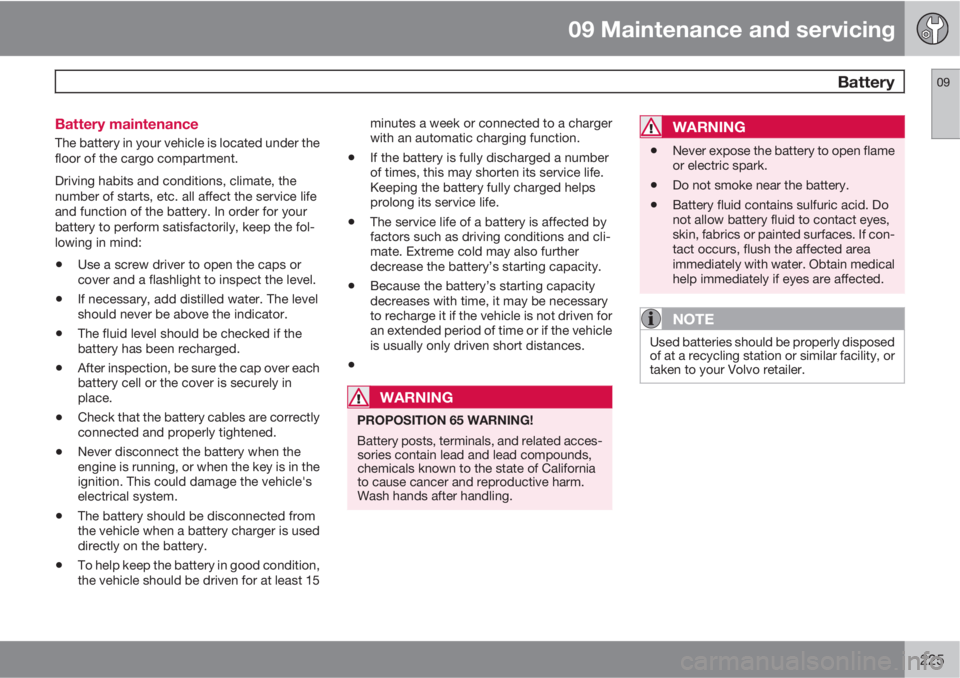
09 Maintenance and servicing
Battery09
225 Battery maintenance
The battery in your vehicle is located under the
floor of the cargo compartment.
Driving habits and conditions, climate, the
number of starts, etc. all affect the service life
and function of the battery. In order for your
battery to perform satisfactorily, keep the fol-
lowing in mind:
•Use a screw driver to open the caps or
cover and a flashlight to inspect the level.
•If necessary, add distilled water. The level
should never be above the indicator.
•The fluid level should be checked if the
battery has been recharged.
•After inspection, be sure the cap over each
battery cell or the cover is securely in
place.
•Check that the battery cables are correctly
connected and properly tightened.
•Never disconnect the battery when the
engine is running, or when the key is in the
ignition. This could damage the vehicle's
electrical system.
•The battery should be disconnected from
the vehicle when a battery charger is used
directly on the battery.
•To help keep the battery in good condition,
the vehicle should be driven for at least 15minutes a week or connected to a charger
with an automatic charging function.
•If the battery is fully discharged a number
of times, this may shorten its service life.
Keeping the battery fully charged helps
prolong its service life.
•The service life of a battery is affected by
factors such as driving conditions and cli-
mate. Extreme cold may also further
decrease the battery’s starting capacity.
•Because the battery’s starting capacity
decreases with time, it may be necessary
to recharge it if the vehicle is not driven for
an extended period of time or if the vehicle
is usually only driven short distances.
•
WARNING
PROPOSITION 65 WARNING!
Battery posts, terminals, and related acces-
sories contain lead and lead compounds,
chemicals known to the state of California
to cause cancer and reproductive harm.
Wash hands after handling.
WARNING
•Never expose the battery to open flame
or electric spark.
•Do not smoke near the battery.
•Battery fluid contains sulfuric acid. Do
not allow battery fluid to contact eyes,
skin, fabrics or painted surfaces. If con-
tact occurs, flush the affected area
immediately with water. Obtain medical
help immediately if eyes are affected.
NOTE
Used batteries should be properly disposed
of at a recycling station or similar facility, or
taken to your Volvo retailer.
Page 228 of 310
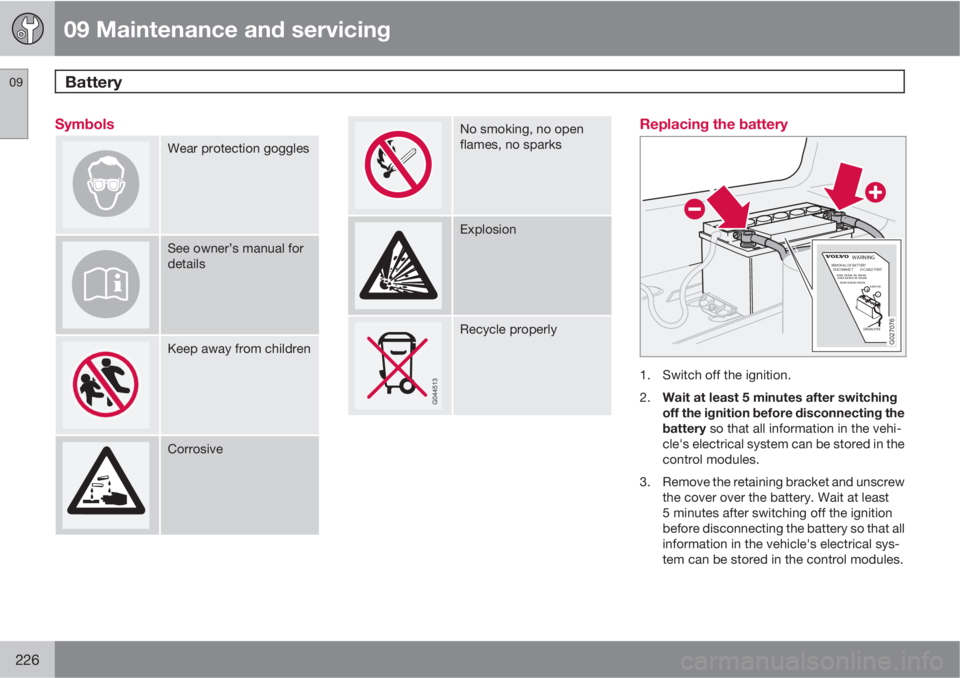
09 Maintenance and servicing
Battery 09
226
Symbols
Wear protection goggles
See owner’s manual for
details
Keep away from children
Corrosive
No smoking, no open
flames, no sparks
Explosion
Recycle properly
Replacing the battery
DRAIN PIPE
xxxx xxxxx xx xxxxx DISCONNECT REMOVAL OF BATTERYO CABLE FIRSTxxxx xxxxx xxxxxxxxx xx+-
WARNING
xxxx xxxxx xx xxxxx
G027076
1. Switch off the ignition.
2.
Wait at least 5 minutes after switching
off the ignition before disconnecting the
battery so that all information in the vehi-
cle's electrical system can be stored in the
control modules.
3. Remove the retaining bracket and unscrew
the cover over the battery. Wait at least
5 minutes after switching off the ignition
before disconnecting the battery so that all
information in the vehicle's electrical sys-
tem can be stored in the control modules.
Page 229 of 310
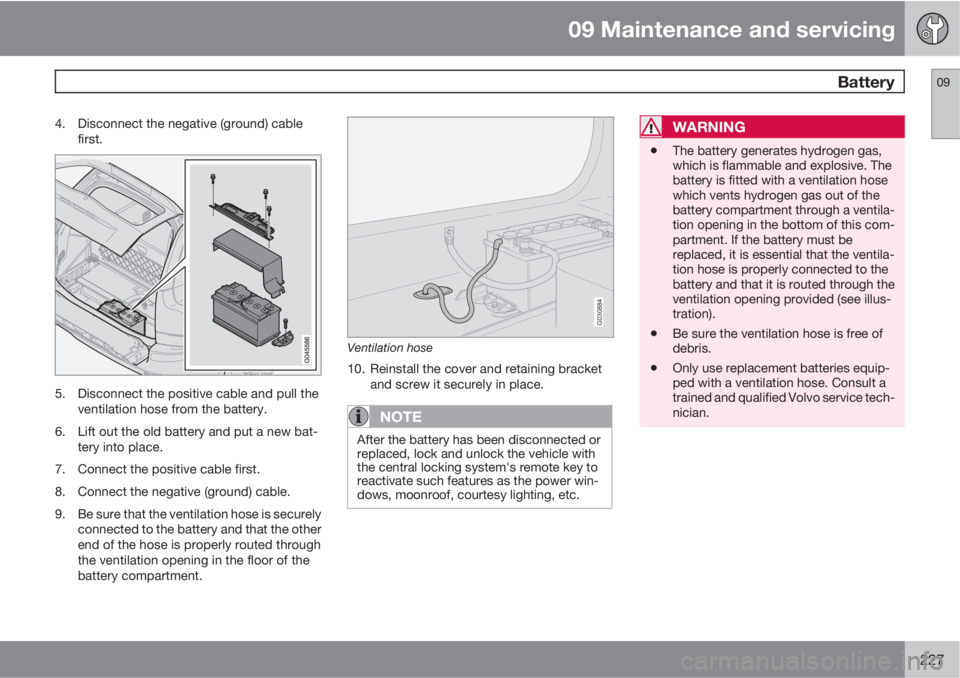
09 Maintenance and servicing
Battery09
227
4. Disconnect the negative (ground) cable
first.
5. Disconnect the positive cable and pull the
ventilation hose from the battery.
6. Lift out the old battery and put a new bat-
tery into place.
7. Connect the positive cable first.
8. Connect the negative (ground) cable.
9. Be sure that the ventilation hose is securely
connected to the battery and that the other
end of the hose is properly routed through
the ventilation opening in the floor of the
battery compartment.
G030884
Ventilation hose
10. Reinstall the cover and retaining bracket
and screw it securely in place.
NOTE
After the battery has been disconnected or
replaced, lock and unlock the vehicle with
the central locking system's remote key to
reactivate such features as the power win-
dows, moonroof, courtesy lighting, etc.
WARNING
•The battery generates hydrogen gas,
which is flammable and explosive. The
battery is fitted with a ventilation hose
which vents hydrogen gas out of the
battery compartment through a ventila-
tion opening in the bottom of this com-
partment. If the battery must be
replaced, it is essential that the ventila-
tion hose is properly connected to the
battery and that it is routed through the
ventilation opening provided (see illus-
tration).
•Be sure the ventilation hose is free of
debris.
•Only use replacement batteries equip-
ped with a ventilation hose. Consult a
trained and qualified Volvo service tech-
nician.
Page 230 of 310
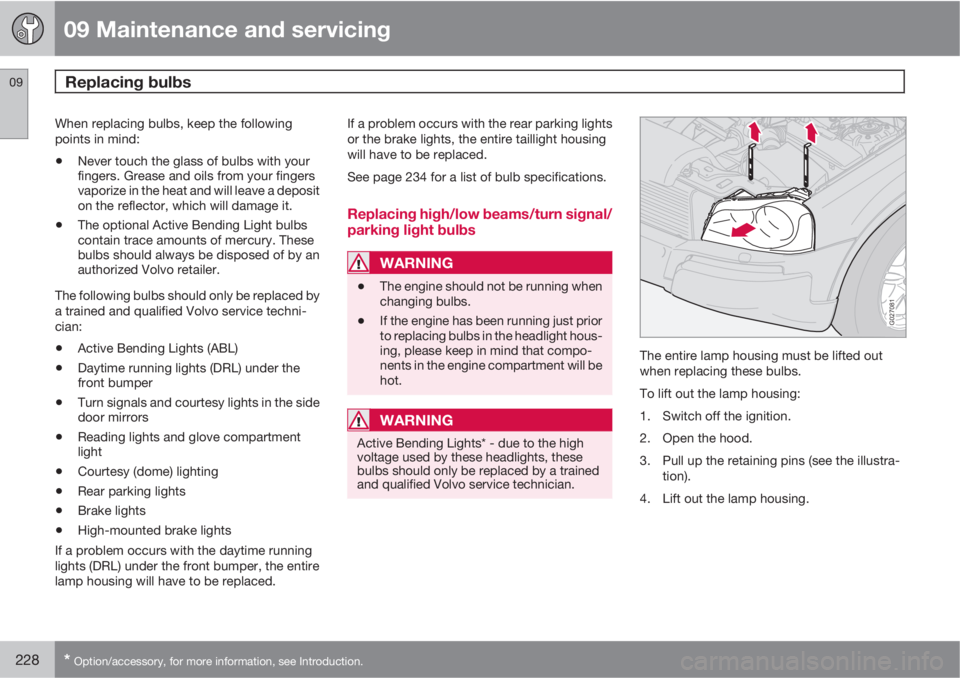
09 Maintenance and servicing
Replacing bulbs 09
228* Option/accessory, for more information, see Introduction.
When replacing bulbs, keep the following
points in mind:
•Never touch the glass of bulbs with your
fingers. Grease and oils from your fingers
vaporize in the heat and will leave a deposit
on the reflector, which will damage it.
•The optional Active Bending Light bulbs
contain trace amounts of mercury. These
bulbs should always be disposed of by an
authorized Volvo retailer.
The following bulbs should only be replaced by
a trained and qualified Volvo service techni-
cian:
•Active Bending Lights (ABL)
•Daytime running lights (DRL) under the
front bumper
•Turn signals and courtesy lights in the side
door mirrors
•Reading lights and glove compartment
light
•Courtesy (dome) lighting
•Rear parking lights
•Brake lights
•High-mounted brake lights
If a problem occurs with the daytime running
lights (DRL) under the front bumper, the entire
lamp housing will have to be replaced.If a problem occurs with the rear parking lights
or the brake lights, the entire taillight housing
will have to be replaced.
See page 234 for a list of bulb specifications.
Replacing high/low beams/turn signal/
parking light bulbs
WARNING
•The engine should not be running when
changing bulbs.
•If the engine has been running just prior
to replacing bulbs in the headlight hous-
ing, please keep in mind that compo-
nents in the engine compartment will be
hot.
WARNING
Active Bending Lights* - due to the high
voltage used by these headlights, these
bulbs should only be replaced by a trained
and qualified Volvo service technician.
G027081
The entire lamp housing must be lifted out
when replacing these bulbs.
To lift out the lamp housing:
1. Switch off the ignition.
2. Open the hood.
3. Pull up the retaining pins (see the illustra-
tion).
4. Lift out the lamp housing.